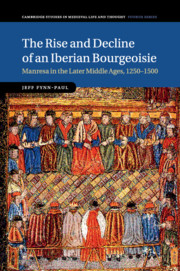Refine search
Actions for selected content:
26946 results in Economic history
Part I - Politics
-
- Book:
- The Rise and Decline of an Iberian Bourgeoisie
- Published online:
- 05 November 2015
- Print publication:
- 05 November 2015, pp 23-166
-
- Chapter
- Export citation

The Rise and Decline of an Iberian Bourgeoisie
- Manresa in the Later Middle Ages, 1250–1500
-
- Published online:
- 05 November 2015
- Print publication:
- 05 November 2015
Contents
-
- Book:
- The Rise and Decline of an Iberian Bourgeoisie
- Published online:
- 05 November 2015
- Print publication:
- 05 November 2015, pp v-vi
-
- Chapter
- Export citation
Chapter 6 - The Aragonese financial revolution
- from Part II - Economy
-
- Book:
- The Rise and Decline of an Iberian Bourgeoisie
- Published online:
- 05 November 2015
- Print publication:
- 05 November 2015, pp 169-210
-
- Chapter
- Export citation
Acknowledgements
-
- Book:
- The Rise and Decline of an Iberian Bourgeoisie
- Published online:
- 05 November 2015
- Print publication:
- 05 November 2015, pp x-xiii
-
- Chapter
- Export citation

An Account of the Introduction of Merino Sheep into the Different States of Europe, and at the Cape of Good Hope
-
- Published online:
- 05 November 2015
- Print publication:
- 20 October 2011
- First published in:
- 1810
Chapter 3 - A portrait of the Manresan patriciate
- from Part I - Politics
-
- Book:
- The Rise and Decline of an Iberian Bourgeoisie
- Published online:
- 05 November 2015
- Print publication:
- 05 November 2015, pp 64-91
-
- Chapter
- Export citation
The Kings of Catalonia-Aragon
-
- Book:
- The Rise and Decline of an Iberian Bourgeoisie
- Published online:
- 05 November 2015
- Print publication:
- 05 November 2015, pp xxii-xxii
-
- Chapter
- Export citation
Glossary
-
- Book:
- The Rise and Decline of an Iberian Bourgeoisie
- Published online:
- 05 November 2015
- Print publication:
- 05 November 2015, pp xiv-xv
-
- Chapter
- Export citation
Chapter 9 - Conclusion
- from Part II - Economy
-
- Book:
- The Rise and Decline of an Iberian Bourgeoisie
- Published online:
- 05 November 2015
- Print publication:
- 05 November 2015, pp 289-306
-
- Chapter
- Export citation
Citibank, Credit Cards, and the Local Politics of National Consumer Finance, 1968–1991
-
- Journal:
- Business History Review / Volume 90 / Issue 1 / Spring 2016
- Published online by Cambridge University Press:
- 26 October 2015, pp. 57-80
- Print publication:
- Spring 2016
-
- Article
-
- You have access
- HTML
- Export citation
RHE volume 33 issue 3 Cover and Back matter
-
- Journal:
- Revista de Historia Economica - Journal of Iberian and Latin American Economic History / Volume 33 / Issue 3 / December 2015
- Published online by Cambridge University Press:
- 23 October 2015, pp. b1-b8
- Print publication:
- December 2015
-
- Article
-
- You have access
- Export citation
RHE volume 33 issue 3 Cover and Front matter
-
- Journal:
- Revista de Historia Economica - Journal of Iberian and Latin American Economic History / Volume 33 / Issue 3 / December 2015
- Published online by Cambridge University Press:
- 23 October 2015, pp. f1-f4
- Print publication:
- December 2015
-
- Article
-
- You have access
- Export citation
Contents
-
- Book:
- A Concise History of International Finance
- Published online:
- 05 October 2015
- Print publication:
- 22 October 2015, pp v-vi
-
- Chapter
- Export citation
5 - The “Big Bang” of financial capitalism: financing and re-financing the Mississippi and South Sea Companies, 1688–1720
-
- Book:
- A Concise History of International Finance
- Published online:
- 05 October 2015
- Print publication:
- 22 October 2015, pp 72-99
-
- Chapter
- Export citation
List of boxes
-
- Book:
- A Concise History of International Finance
- Published online:
- 05 October 2015
- Print publication:
- 22 October 2015, pp x-x
-
- Chapter
- Export citation
2 - Distant beginnings: the first 3,000 years
-
- Book:
- A Concise History of International Finance
- Published online:
- 05 October 2015
- Print publication:
- 22 October 2015, pp 15-27
-
- Chapter
- Export citation
7 - Financial innovations during the “birth of the modern,” 1789–1830: a tale of three revolutions
-
- Book:
- A Concise History of International Finance
- Published online:
- 05 October 2015
- Print publication:
- 22 October 2015, pp 134-165
-
- Chapter
- Export citation
List of tables
-
- Book:
- A Concise History of International Finance
- Published online:
- 05 October 2015
- Print publication:
- 22 October 2015, pp xi-xii
-
- Chapter
- Export citation
Preface
-
- Book:
- A Concise History of International Finance
- Published online:
- 05 October 2015
- Print publication:
- 22 October 2015, pp xiii-xiv
-
- Chapter
- Export citation
